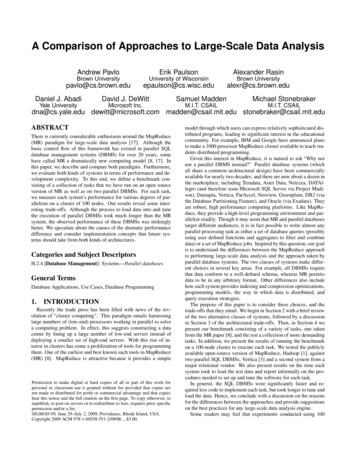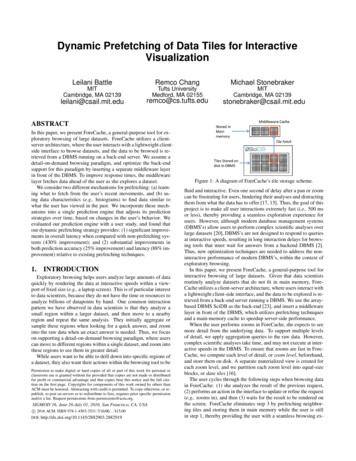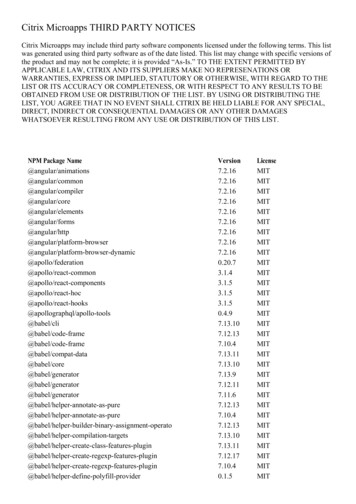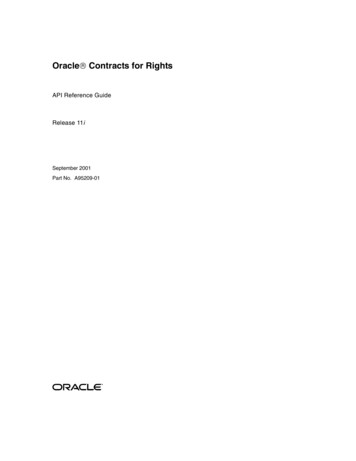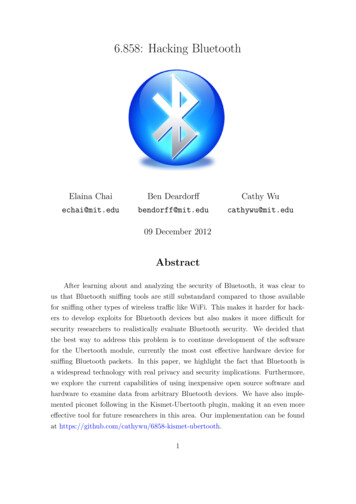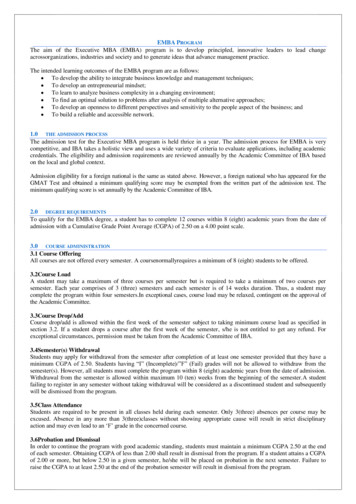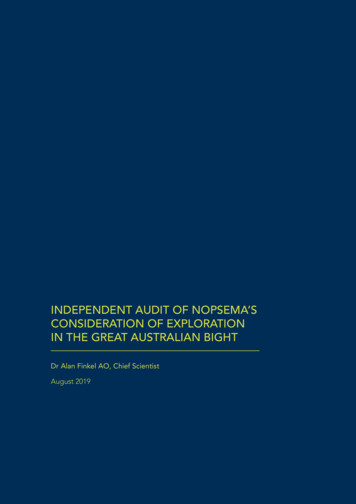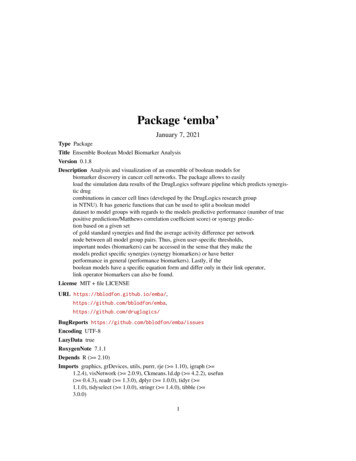
Transcription
Package ‘emba’January 7, 2021Type PackageTitle Ensemble Boolean Model Biomarker AnalysisVersion 0.1.8Description Analysis and visualization of an ensemble of boolean models forbiomarker discovery in cancer cell networks. The package allows to easilyload the simulation data results of the DrugLogics software pipeline which predicts synergistic drugcombinations in cancer cell lines (developed by the DrugLogics research groupin NTNU). It has generic functions that can be used to split a boolean modeldataset to model groups with regards to the models predictive performance (number of truepositive predictions/Matthews correlation coefficient score) or synergy prediction based on a given setof gold standard synergies and find the average activity difference per networknode between all model group pairs. Thus, given user-specific thresholds,important nodes (biomarkers) can be accessed in the sense that they make themodels predict specific synergies (synergy biomarkers) or have betterperformance in general (performance biomarkers). Lastly, if theboolean models have a specific equation form and differ only in their link operator,link operator biomarkers can also be found.License MIT file LICENSEURL eports https://github.com/bblodfon/emba/issuesEncoding UTF-8LazyData trueRoxygenNote 7.1.1Depends R ( 2.10)Imports graphics, grDevices, utils, purrr, rje ( 1.10), igraph ( 1.2.4), visNetwork ( 2.0.9), Ckmeans.1d.dp ( 4.2.2), usefun( 0.4.3), readr ( 1.3.0), dplyr ( 1.0.0), tidyr ( 1.1.0), tidyselect ( 1.0.0), stringr ( 1.4.0), tibble ( 3.0.0)1
R topics documented:2Suggests testthat, knitr, rmarkdown, xfunVignetteBuilder knitrNeedsCompilation noAuthor John Zobolas [aut, cph, cre] ( https://orcid.org/0000-0002-3609-8674 )Maintainer John Zobolas bblodfon@gmail.com Repository CRANDate/Publication 2021-01-07 04:00:02 UTCR topics documented:add numbers above the bars . . . . . . . . . . . . . . . . . . . . . .assign link operator value to equation . . . . . . . . . . . . . . . . .biomarker mcc analysis . . . . . . . . . . . . . . . . . . . . . . . . .biomarker synergy analysis . . . . . . . . . . . . . . . . . . . . . . .biomarker tp analysis . . . . . . . . . . . . . . . . . . . . . . . . . .calculate mcc . . . . . . . . . . . . . . . . . . . . . . . . . . . . . . .calculate models mcc . . . . . . . . . . . . . . . . . . . . . . . . . .calculate models synergies fn . . . . . . . . . . . . . . . . . . . . . .calculate models synergies fp . . . . . . . . . . . . . . . . . . . . . .calculate models synergies tn . . . . . . . . . . . . . . . . . . . . . .calculate models synergies tp . . . . . . . . . . . . . . . . . . . . . .construct network . . . . . . . . . . . . . . . . . . . . . . . . . . . . .count models that predict synergies . . . . . . . . . . . . . . . . . .emba . . . . . . . . . . . . . . . . . . . . . . . . . . . . . . . . . . . .filter network . . . . . . . . . . . . . . . . . . . . . . . . . . . . . . .get alt drugname . . . . . . . . . . . . . . . . . . . . . . . . . . . . .get avg activity diff based on mcc clustering . . . . . . . . . . . . .get avg activity diff based on specific synergy prediction . . . . . .get avg activity diff based on synergy set cmp . . . . . . . . . . .get avg activity diff based on tp predictions . . . . . . . . . . . . .get avg activity diff mat based on mcc clustering . . . . . . . . . .get avg activity diff mat based on specific synergy prediction . . .get avg activity diff mat based on tp predictions . . . . . . . . . .get avg link operator diff based on synergy set cmp . . . . . . . .get avg link operator diff mat based on mcc clustering . . . . . . .get avg link operator diff mat based on specific synergy predictionget avg link operator diff mat based on tp predictions . . . . . . .get biomarkers . . . . . . . . . . . . . . . . . . . . . . . . . . . . . .get biomarkers per type . . . . . . . . . . . . . . . . . . . . . . . . .get edges from topology file . . . . . . . . . . . . . . . . . . . . . .get fitness from models dir . . . . . . . . . . . . . . . . . . . . . . .get link operators from models dir . . . . . . . . . . . . . . . . . . .get models based on mcc class id . . . . . . . . . . . . . . . . . . .get model names . . . . . . . . . . . . . . . . . . . . . . . . . . . . .get model predictions . . . . . . . . . . . . . . . . . . . . . . . . . .get neighbors . . . . . . . . . . . . . . . . . . . . . . . . . . . . . . 343637373839404041
add numbers above the barsget node colors . . . . . . . . . . . . . .get node names . . . . . . . . . . . . .get observed model predictions . . . . .get observed synergies . . . . . . . . . .get observed synergies per cell line . .get perf biomarkers per cell line . . . .get stable state from models dir . . . .get synergy biomarkers from dir . . . .get synergy biomarkers per cell line . .get synergy comparison sets . . . . . .get synergy scores . . . . . . . . . . . .get synergy subset stats . . . . . . . . .get unobserved model predictions . . .get vector diff . . . . . . . . . . . . . .get x axis values . . . . . . . . . . . . .is comb element of . . . . . . . . . . .make barplot on models stats . . . . . .make barplot on synergy subset stats .plot avg link operator diff graph . . . .plot avg link operator diff graphs . . .plot avg state diff graph . . . . . . . .plot avg state diff graphs . . . . . . . .plot avg state diff graph vis . . . . . .plot mcc classes hist . . . . . . . . . . .print biomarkers per predicted synergyprint model and drug stats . . . . . . .update biomarker files . . . . . . . . . .validate observed synergies data . . . 85959606162626365add numbers above the barsAdd numbers horizontally above the bars of a barplotDescriptionAdd numbers horizontally above the bars of a barplotUsageadd numbers above the bars(stats, bp, color)Argumentsstatsbpcolor.a numeric vectorthe result of barplot command, usually a numeric vector or matrixstring. The color for the numbers
4biomarker mcc analysisassign link operator value to equationAssign link operator value to boolean equationDescriptionAssign link operator value to boolean equationUsageassign link operator value to equation(equation)Argumentsequationstring. The boolean equation in the form T arget (ActivatororActivatoror.)andnot(InhibitororIValue1 if the equation has the ’or not’ link operator, 0 if the equation has the ’and not’ link operatorand NA if it has neither.biomarker mcc analysisBiomarker analysis based on MCC model classificationDescriptionUse this function to perform a full biomarker analysis on an ensemble boolean model dataset wherethe model classification is based on the Matthews correlation coefficient score (MCC). This analysis enables the discovery of performance biomarkers, nodes whose activity and/or boolean modelparameterization (link operator) affects the prediction performance of the models (as measured bythe MCC score).Usagebiomarker mcc els.link.operator es 5,penalty 0.1)
biomarker mcc analysis5Argumentsmodel.predictionsa data.frame object with rows the models and columns the drug combinations.Possible values for each model-drug combination element are either 0 (no synergy predicted), 1 (synergy was predicted) or NA (couldn’t find stable states ineither the drug combination inhibited model or in any of the two single-druginhibited models).models.stable.statea data.frame (nxm) with n models and m nodes. The row names specify themodels’ names whereas the column names specify the network nodes (gene,proteins, etc.). Possible values for each model-node element can be between 0(inactive node) and 1 (active node) inclusive. Note that the rows (models) haveto be in the same order as in the model.predictions parameter.models.link.operatora data.frame (nxm) with n models and m nodes. The row names specify themodels’ names (same order as in the model.predictions parameter) whereasthe column names specify the network nodes (gene, proteins, etc.). Possiblevalues for each model-node element are either 0 (AND NOT link operator), 1(OR NOT link operator) or 0.5 if the node is not targeted by both activating andinhibiting regulators (no link operator). Default value: NULL (no analysis onthe models parameterization regarding the mutation of the boolean equation linkoperator will be done).observed.synergiesa character vector with elements the names of the drug combinations that werefound as synergistic. This should be a subset of the tested drug combinations,that is the column names of the model.predictions parameter.numeric. A number in the [0,1] interval, above which (or below its negativevalue) a biomarker will be registered in the returned result. Values closer to 1translate to a more strict threshold and thus less biomarkers are found.num.of.mcc.classesnumeric. A positive integer larger than 2 that signifies the number of mcc classes(groups) that we should split the models MCC values. Default value: 5.thresholdpenaltyvalue between 0 and 1 (inclusive). A value of 0 means no penalty and a valueof 1 is the strickest possible penalty. Default value is 0.1. This penalty is usedas part of a weighted term to the difference in a value of interest (e.g. activityor link operator difference) between two group of models, to account for thedifference in the number of models from each respective model group.Valuea list with various elements: predicted.synergies: a character vector of the synergies (drug combination names) thatwere predicted by at least one of the models in the dataset. models.mcc: a numeric vector of MCC scores, one for each model. Values are in the [-1,1]interval.
6biomarker synergy analysis diff.state.mcc.mat: a matrix whose rows are vectors of average node activity state differences between two groups of models where the classification was based on the MCCscore of each model and was found using an optimal univariate k-means clustering method(Ckmeans.1d.dp). Rows represent the different classification group matchings, e.g. (1,2)means the models that were classified into the first MCC class vs the models that were classified in the 2nd class (higher is better). The columns represent the network’s node names.Values are in the [-1,1] interval. biomarkers.mcc.active: a character vector whose elements are the names of the active statebiomarkers. These nodes appear more active in the better performance models. biomarkers.mcc.inhibited: a character vector whose elements are the names of the inhibited state biomarkers. These nodes appear more inhibited in the better performance models. diff.link.mcc.mat: a matrix whose rows are vectors of average node link operator differences between two groups of models where the classification was based on the MCCscore of each model and was found using an optimal univariate k-means clustering method(Ckmeans.1d.dp). Rows represent the different classification group matchings, e.g. (1,2)means the models that were classified into the first MCC class vs the models that were classified in the 2nd class (higher is better). The columns represent the network’s node names.Values are in the [-1,1] interval. biomarkers.mcc.or: a character vector whose elements are the names of the OR link operator biomarkers. These nodes have mostly the OR link operator in their respective booleanequations in the better performance models. biomarkers.mcc.and: a character vector whose elements are the names of the AND link operator biomarkers. These nodes have mostly the AND link operator in their respective booleanequations in the better performance models.See AlsoOther general analysis functions: biomarker synergy analysis(), biomarker tp analysis()biomarker synergy analysisBiomarker analysis per synergy predictedDescriptionUse this function to discover synergy biomarkers, i.e. nodes whose activity and/or boolean equationparameterization (link operator) affect the manifestation of synergies in the boolean models. Modelsare classified to groups based on whether they predict or not each of the predicted synergies.Usagebiomarker synergy els.link.operator NULL,
biomarker synergy bsets.stats FALSE,penalty 0.1)Argumentsmodel.predictionsa data.frame object with rows the models and columns the drug combinations.Possible values for each model-drug combination element are either 0 (no synergy predicted), 1 (synergy was predicted) or NA (couldn’t find stable states ineither the drug combination inhibited model or in any of the two single-druginhibited models).models.stable.statea data.frame (nxm) with n models and m nodes. The row names specify themodels’ names whereas the column names specify the network nodes (gene,proteins, etc.). Possible values for each model-node element can be between 0(inactive node) and 1 (active node) inclusive. Note that the rows (models) haveto be in the same order as in the model.predictions parameter.models.link.operatora data.frame (nxm) with n models and m nodes. The row names specify themodels’ names (same order as in the model.predictions parameter) whereasthe column names specify the network nodes (gene, proteins, etc.). Possiblevalues for each model-node element are either 0 (AND NOT link operator), 1(OR NOT link operator) or 0.5 if the node is not targeted by both activating andinhibiting regulators (no link operator). Default value: NULL (no analysis onthe models parameterization regarding the mutation of the boolean equation linkoperator will be done).observed.synergiesa character vector with elements the names of the drug combinations that werefound as synergistic. This should be a subset of the tested drug combinations,that is the column names of the model.predictions parameter.numeric. A number in the [0,1] interval, above which (or below its negativevalue) a biomarker will be registered in the returned result. Values closer to 1translate to a more strict threshold and thus less biomarkers are found.calculate.subsets.statslogical. If TRUE, then the results will include a vector of integers, representingthe number of models that predicted every subset of the given observed.synergies(where at least one model predicts every synergy in the subset). The defaultvalue is FALSE, since the powerset of the predicted observed.synergies canbe very large to compute.thresholdpenaltyvalue between 0 and 1 (inclusive). A value of 0 means no penalty and a valueof 1 is the strickest possible penalty. Default value is 0.1. This penalty is usedas part of a weighted term to the difference in a value of interest (e.g. activityor link operator difference) between two group of models, to account for thedifference in the number of models from each respective model group.
8biomarker tp analysisValuea list with various elements: predicted.synergies: a character vector of the synergies (drug combination names) thatwere predicted by at least one of the models in the dataset. synergy.subset.stats: an integer vector with elements the number of models the predictedeach observed synergy subset if the calculate.subsets.stats option is enabled. synergy.comparison.sets: a data.frame with pairs of (set, subset) for each model-predictedsynergy where each respective subset misses just one synergy from the larger set (present onlyif the calculate.subsets.stats option is enabled). Can be used to refine the synergy biomarkersby comparing any two synergy sets with the functions get avg activity diff based on synergy set cmpor get avg link operator diff based on synergy set cmp. diff.state.synergies.mat: a matrix whose rows are vectors of average node activitystate differences between two groups of models where the classification for each individualrow was based on the prediction or not of a specific synergistic drug combination. The rownames are the predicted synergies, one per row, while the columns represent the network’snode names. Values are in the [-1,1] interval. activity.biomarkers: a data.frame object with rows the predicted synergies and columnsthe nodes (column names of the models.stable.states matrix). Possible values for eachsynergy-node element are either 1 (active state biomarker), -1 (inhibited state biomarker) or 0(not a biomarker) for the given threshold value. diff.link.synergies.mat: a matrix whose rows are vectors of average node link operator differences between two groups of models where the classification for each individualrow was based on the prediction or not of a specific synergistic drug combination. The rownames are the predicted synergies, one per row, while the columns represent the network’snode names. Values are in the [-1,1] interval. link.operator.biomarkers: a data.frame object with rows the predicted synergiesand columns the nodes (column names of the models.link.operator matrix). Possible values for each synergy-node element are either 1 (OR link operator biomarker), -1 (AND linkoperator biomarker) or 0 (not a biomarker) for the given threshold value.See AlsoOther general analysis functions: biomarker mcc analysis(), biomarker tp analysis()biomarker tp analysis Biomarker analysis based on TP model classificationDescriptionUse this function to perform a full biomarker analysis on an ensemble boolean model dataset wherethe model classification is based on the number of true positive (TP) predictions. This analysisenables the discovery of performance biomarkers, nodes whose activity and/or boolean model parameterization (link operator) affects the prediction performance of the models (as measured by thenumber of TPs).
biomarker tp analysis9Usagebiomarker tp els.link.operator NULL,observed.synergies,threshold,penalty 0.1)Argumentsmodel.predictionsa data.frame object with rows the models and columns the drug combinations.Possible values for each model-drug combination element are either 0 (no synergy predicted), 1 (synergy was predicted) or NA (couldn’t find stable states ineither the drug combination inhibited model or in any of the two single-druginhibited models).models.stable.statea data.frame (nxm) with n models and m nodes. The row names specify themodels’ names whereas the column names specify the network nodes (gene,proteins, etc.). Possible values for each model-node element can be between 0(inactive node) and 1 (active node) inclusive. Note that the rows (models) haveto be in the same order as in the model.predictions parameter.models.link.operatora data.frame (nxm) with n models and m nodes. The row names specify themodels’ names (same order as in the model.predictions parameter) whereasthe column names specify the network nodes (gene, proteins, etc.). Possiblevalues for each model-node element are either 0 (AND NOT link operator), 1(OR NOT link operator) or 0.5 if the node is not targeted by both activating andinhibiting regulators (no link operator). Default value: NULL (no analysis onthe models parameterization regarding the mutation of the boolean equation linkoperator will be done).observed.synergiesa character vector with elements the names of the drug combinations that werefound as synergistic. This should be a subset of the tested drug combinations,that is the column names of the model.predictions parameter.thresholdnumeric. A number in the [0,1] interval, above which (or below its negativevalue) a biomarker will be registered in the returned result. Values closer to 1translate to a more strict threshold and thus less biomarkers are found.penaltyvalue between 0 and 1 (inclusive). A value of 0 means no penalty and a valueof 1 is the strickest possible penalty. Default value is 0.1. This penalty is usedas part of a weighted term to the difference in a value of interest (e.g. activityor link operator difference) between two group of models, to account for thedifference in the number of models from each respective model group.
10calculate mccValuea list with various elements: predicted.synergies: a character vector of the synergies (drug combination names) thatwere predicted by at least one of the models in the dataset. models.synergies.tp: an integer vector of true positive (TP) values, one for each model. diff.tp.mat: a matrix whose rows are vectors of average node activity state differencesbetween two groups of models where the classification was based on the number of true positive predictions. Rows represent the different classification group matchings, e.g. (1,2) meansthe models that predicted 1 TP synergy vs the models that predicted 2 TP synergies and thecolumns represent the network’s node names. Values are in the [-1,1] interval. biomarkers.tp.active: a character vector whose elements are the names of the active statebiomarkers. These nodes appear as more active in the better performance models. biomarkers.tp.inhibited: a character vector whose elements are the names of the inhibitedstate biomarkers. These nodes appear as more inhibited in the better performance models. diff.link.tp.mat: a matrix whose rows are vectors of average node link operator differences between two groups of models where the classification was based on the number of truepositive predictions. Rows represent the different classification group matchings, e.g. (1,2)means the models that predicted 1 TP synergy vs the models that predicted 2 TP synergies andthe columns represent the network’s node names. Values are in the [-1,1] interval. biomarkers.tp.or: a character vector whose elements are the names of the OR link operator biomarkers. These nodes have mostly the OR link operator in their respective booleanequations in the better performance models. biomarkers.tp.and: a character vector whose elements are the names of the AND link operator biomarkers. These nodes have mostly the AND link operator in their respective booleanequations in the better performance models.See AlsoOther general analysis functions: biomarker mcc analysis(), biomarker synergy analysis()calculate mccCalculate Matthews correlation coefficient vectorDescriptionUse this function to calculate the MCC scores given vectors of TP (true positives), FP (false positives), TN (true negatives) and FN (false negatives) values. Note that the input vectors have to be ofthe same size and have one-to-one value correspondence for the output MCC vector to make sense.Usagecalculate mcc(tp, tn, fp, fn)
calculate models mcc11Argumentstpnumeric vector of TPstnnumeric vector of TNsfpnumeric vector of FPsfnnumeric vector of FNsValuea numeric vector of MCC values, each value being in the [-1,1] interval. If any of the four sumsof the MCC formula are zero, then we return an MCC score of zero, which can be shown to bethe correct limiting value (model is no better than a random predictor, see Chicco et al. (2020),doi: 10.1186/s1286401964137).See AlsoOther confusion matrix calculation functions: calculate models mcc(), calculate models synergies fn(),calculate models synergies fp(), calculate models synergies tn(), calculate models synergies tp()calculate models mccCalculate the Matthews correlation coefficient for each modelDescriptionCalculate the Matthews correlation coefficient for each modelUsagecalculate models rved.model.predictionsdata.frame object with rows the models and columns the drug combinationsthat were found as synergistic (positive results). Possible values for each modeldrug combination element are either 0 (no synergy predicted), 1 (synergy waspredicted) or NA (couldn’t find stable states in either the drug combination inhibited model or in any of the two single-drug inhibited models)unobserved.model.predictionsdata.frame object with rows the models and columns the drug combinationsthat were found as non-synergistic (negative results). Possible values for eachmodel-drug combination element are either 0 (no synergy predicted), 1 (synergywas predicted) or NA (couldn’t find stable states in either the drug combinationinhibited model or in any of the two single-drug inhibited models)
12calculate models synergies fnnumber.of.drug.comb.testednumeric. The total number of drug combinations tested, which should be equalto the sum of the columns of the observed.model.predictions and the unobserved.model.predictioValuea numeric vector of MCC values, each value being in the [-1,1] interval. The names attribute holdsthe models’ names if applicable (i.e. the input data.frames have rownames).See AlsoOther confusion matrix calculation functions: calculate mcc(), calculate models synergies fn(),calculate models synergies fp(), calculate models synergies tn(), calculate models synergies tp()calculate models synergies fnCount the non-synergies of the observed synergies per model (FN)DescriptionSince the given observed.model.predictions data.frame has only the positive results, this function returns the total number of 0’s and NA’s in each row.Usagecalculate models synergies del.predictionsdata.frame object with rows the models and columns the drug combinationsthat were found/observed as synergistic (negative results). Possible values foreach model-drug combination element are either 0 (no synergy predicted), 1(synergy was predicted) or NA (couldn’t find stable states in either the drugcombination inhibited model or in any of the two single-drug inhibited models)Valuean integer vector with elements the number of false negative predictions per model. The modelnames are given in the names attribute (same order as in the rownames attribute of the observed.model.predictionsdata.frame).See AlsoOther confusion matrix calculation functions: calculate mcc(), calculate models mcc(), calculate models synergicalculate models synergies tn(), calculate models synergies tp()
calculate models synergies fp13calculate models synergies fpCount the predictions of the non-synergistic drug combinations permodel (FP)DescriptionSince the given unobserved.model.predictions data.frame has only the negative results, thisfunction returns the total number of 1’s in each row.Usagecalculate models synergies d.model.predictionsdata.frame object with rows the models and columns the drug combinationsthat were found/observed as non-synergistic (negative results). Possible valuesfor each model-drug combination element are either 0 (no synergy predicted),1 (synergy was predicted) or NA (couldn’t find stable states in either the drugcombination inhibited model or in any of the two single-drug inhibited models)Valuean integer vector with elements the number of false positive predictions per model. The modelnames are given in the names attribute (same order as in the rownames attribute of the unobserved.model.predictions data.frame).See AlsoOther confusion matrix calculation functions: calculate mcc(), calculate models mcc(), calculate models synergicalculate models synergies tn(), calculate models synergies tp()calculate models synergies tnCount the non-synergies of the non-synergistic drug combinations permodel (TN)DescriptionSince the given unobserved.model.predictions data.frame has only the negative results, thisfunction returns the total number of 0’s and NA’s in each row.
14calculate models synergies tpUsagecalculate models synergies d.model.predictionsdata.frame object with rows the models and columns the drug combinationsthat were found/observed as non-synergistic (negative results). Possible valuesfor each model-drug combination element are either 0 (no synergy predicted),1 (synergy was predicted) or NA (couldn’t find stable states in either the drugcombination inhibited model or in any of the two single-drug inhibited models)Valuean integer vector with elements the number of true negative predictions per model. The modelnames are given in the names attribute (same order as in the rownames attribute of the unobserved.model.predictions data.frame).See AlsoOther confusion matrix calculation functions: calculate mcc(), calculate models mcc(), calculate models synergicalculate models synergies fp(), calculate models synergies tp()calculate models synergies tpCount the predictions of the observed synergies per model (TP)DescriptionSince the given observed.model.predictions data.frame has only the positive results, this function returns the total number of 1’s in each row.Usagecalculate models synergies del.predictionsdata.frame object with rows the models and columns the drug combin
Package 'emba' January 7, 2021 Type Package Title Ensemble Boolean Model Biomarker Analysis Version 0.1.8 Description Analysis and visualization of an ensemble of boolean models for biomarker discovery in cancer cell networks. The package allows to easily load the simulation data results of the DrugLogics software pipeline which predicts .
